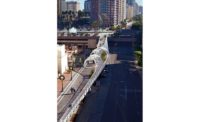Cutting in half the number of piers on a toll-funded Interstate bridge made the litany of obstacles beneath it more manageable.
Crews are building a pair of nearly mile-long new highway bridges amid a confluence of existing transportation systems in Chicago’s southwest suburbs. There’s the Des Plaines River, the Chicago Sanitary and Ship Canal, the Illinois and Michigan Canal, two sets of major railroad tracks, local roads and a pipeline operated by Buckeye Partners that sends jet fuel to O’Hare airport.
The Mile-Long Bridge is a crucial piece of infrastructure on the Central Tri-State (Interstate 294). Its two bridges carry commuters and commerce over all of those existing systems, and the divided highway intersects I-55 in the same area. Midway Airport, another transportation hub, is less than five miles away. There is also a United Parcel Service Distribution Center and a railyard for Burlington Northern Santa Fe Railway.
Originally constructed in 1958 with the rest of the Illinois Tollway, the Central Tri-State’s mile-long bridges were due for replacement. With only four lanes in each direction and more than 150,000 vehicles traveling over them daily, congestion was worsening, and the 22 miles of the Central Tri-State around them also carry the heaviest volumes of freight traffic on the system.
AECOM serves as the design corridor manager for the Central Tri-State project, a multi-year expansion and modernization of which the Mile Long Bridge is just one piece. Omega Associates is the Construction Corridor Manager/Owner’s Representative. The Central State Project’s total cost is expected to be $4 billion, itself a part of a 15-year, $14-billion Move Illinois program approved in 2011 to be funded by tollway revenue and bond proceeds.
To replace the old bridges, two new structure were designed by LHQ Tri-State Partners, a joint venture of HDR, HW Lochner and Quigg. Reducing the number of piers on the new structures proved critical. “What [the design team] did was they were able to reduce the number of piers. We had 106 existing piers. So each one of our new structures—and I’m talking structures plural, because we have a separate bridge for carrying northbound and a separate bridge for carrying southbound—each one of those is going to have only 26 piers,” says Paul Kovacs, chief engineer at the Illinois Tollway Authority. “Fifty-two is a lot less than 106. They really did a great job. That is definitely minimizing the environmental impact and minimizing the impact on those existing operations under there.”
The first of the two adjacent 4,800-ft-long bridges, the northbound one, is expected be completed by general contractor F.H. Paschen S.N. Nielsen Inc. by the end of the year in a $184.6-million effort. The southern bridge goes out to bid later this month. The total planned cost of both spans is $500 million including demolition of the old bridges. The new bridges will have five lanes in both directions, and the inside shoulders will be able to serve as flex lanes. Each of the bridges will have 27 spans supported by the aforementioned 26 piers.
Paschen and construction manager Bowman Consulting were able to build the northbound structure without affecting traffic at all. The existing spans are open, one directly adjacent to the new northbound bridge. Once northbound I-294 is completed, traffic will shift and the old northbound lanes and structures will be demolished. That was about the only constructability advantage the site had.
“The area’s littered with obstacles, not even just the Buckeye [jet fuel] line, but just other pipelines and utilities that required a lot of utility protection with the equipment that we have coming in,” says Tim Bea, senior project manager with F.H. Paschen. “We had to create engineered protection plans. The Buckeye line is getting relocated, but that has run into some hiccups, so we’re still protecting the existing location of that Buckeye line. There’s a big 36-inch water main down the south end of the job by Pier 1.”
Because the design calls for fewer piers, the spans are all longer. The concrete beams, produced by County Materials in Janesville, Wis., can reach up to 7.5 ft tall, are between 106 and 187 ft long and weigh up to 122.5 tons. These California wide-flange beams are the largest concrete beams ever produced by County Materials and the largest ever used in Illinois, according to the supplier. The concrete beams were a great solution for the straight portions of the bridge, but the curving parts called for steel. Industrial Steel Construction, headquartered on the other side of the Tri-State Tollway in Gary, Ind., fabricated 110 steel beams, each 10 ft tall and ranging in length from 57 ft to 134 ft.
Steel erector Danny’s Construction Co. was able to install the steel bridge girders on the north and south ends of the project traditionally, but there remained a 134-ft gap that crossed the Chicago Sanitary and Ship Canal. After building their own onsite dock, the steel erector crews used a Manitowoc crane on a barge over the canal to place and bolt the remaining beams. Because the Buckeye jet fuel line runs under the canal, they could only raise the steel bridge sections from one side of the bridge to avoid coming within 50 ft of the pipeline. The barge’s spuds are anchored in place far enough away from the line, and the crane picks were all well within safe tolerances. Danny’s Construction crews from Ironworkers Local 1 used lifts and platforms for the bolting operations.
“There’s a typical girder splice we have,” says Andy Balke, division manager at Danny’s Construction. “Top flange, bottom flange, strap plates, and they have bolts on either side.”
The bridge deck was also challenging because of the remoteness of the site and the need to bring in ready-mix trucks from Chicagoland concrete supplier Ozinga. The Tollway’s proprietary mix would have to be checked in both the truck and on the deck.
“We test every load down here [on the ground] and then we have a random number system that’s set up where we’ll test air content, slump and temperature up on the bridge deck as well,” says Tim Jenkins, quality control manager with F.H. Paschen. Trucks arrived at the site roughly every five to six minutes, and Paschen’s crew would perform the ground test before moving them along to pump to the deck. Coordinated movements allowed each truck to leave using the narrow corridor it arrived in, just as another took its place.
The rigor of the mix uniformity is measured by Paschen, Bowman Consulting and, in some cases, the Illinois Tollway Authority.
“The tollway has been using a high performance concrete mix for all its decks for the last 10 years,” says Jeff Allen, senior project engineer with the Illinois Tollway Authority. “It’s a proprietary mix by the producers. It’s a performance-based, special provision basically on what we desire for the strength and the permeability of the concrete. We have a contractor quality program. We pay the contractor to perform the quality control tests. Along with that, we also have quality assurance being provided by the construction manager. We also have independent assurance. That’s more of a corridor-wide thing where we’re doing spot checks of different things on a corridor basis [to guarnatee consistency in] testing and materials and how we’re documenting things.”
The bridge deck sports stainless steel rebar in hopes of providing a 100-year design life. Each of the drill shafts for the piers is 40 to 45 ft deep.
“It actually goes into the pier caps where we have expansion joints, so that also enhanced the lifespan of the pier caps,” Allen says. “There’s 7 million pounds of stainless on the project.”
The COVID-19 pandemic hit just as crews were beginning to place beams. Thanks to Illinois designating construction an essential service, the project continued. Jenkins says it’s still on schedule to be completed by Nov. 9 with safety precautions in place.
In addition to the widening of the bridges, the project also involves modernizing local interchanges, sewer systems, utility stations and road and rail freight traffic that all come together in that same area near Willow Springs, Hodgkins and Burr Ridge, Ill.
“We know we’re going to improve the traffic flow, and we benefit directly from that, too,” Kovacs says. “We’re going to make additional accommodations for freight on the corridor. That was one industry that we heard from that would benefit. We have regional stormwater solutions being developed for the corridor, so I really liked the fact that we’re getting the most out of our investment, and we’re serving the greatest amount of people. That’s important for the tollway.”












Post a comment to this article
Report Abusive Comment